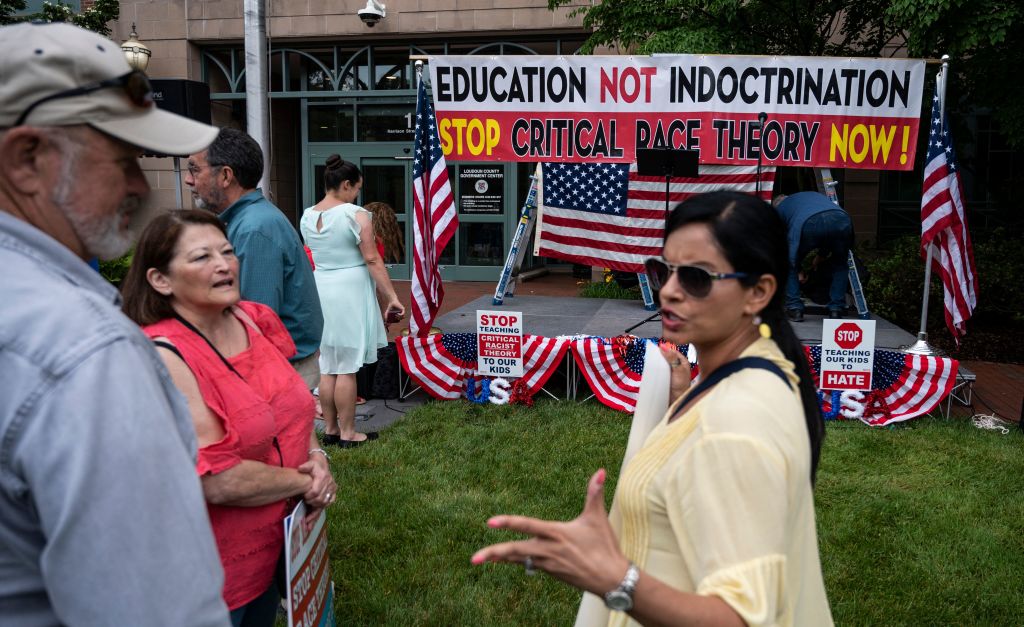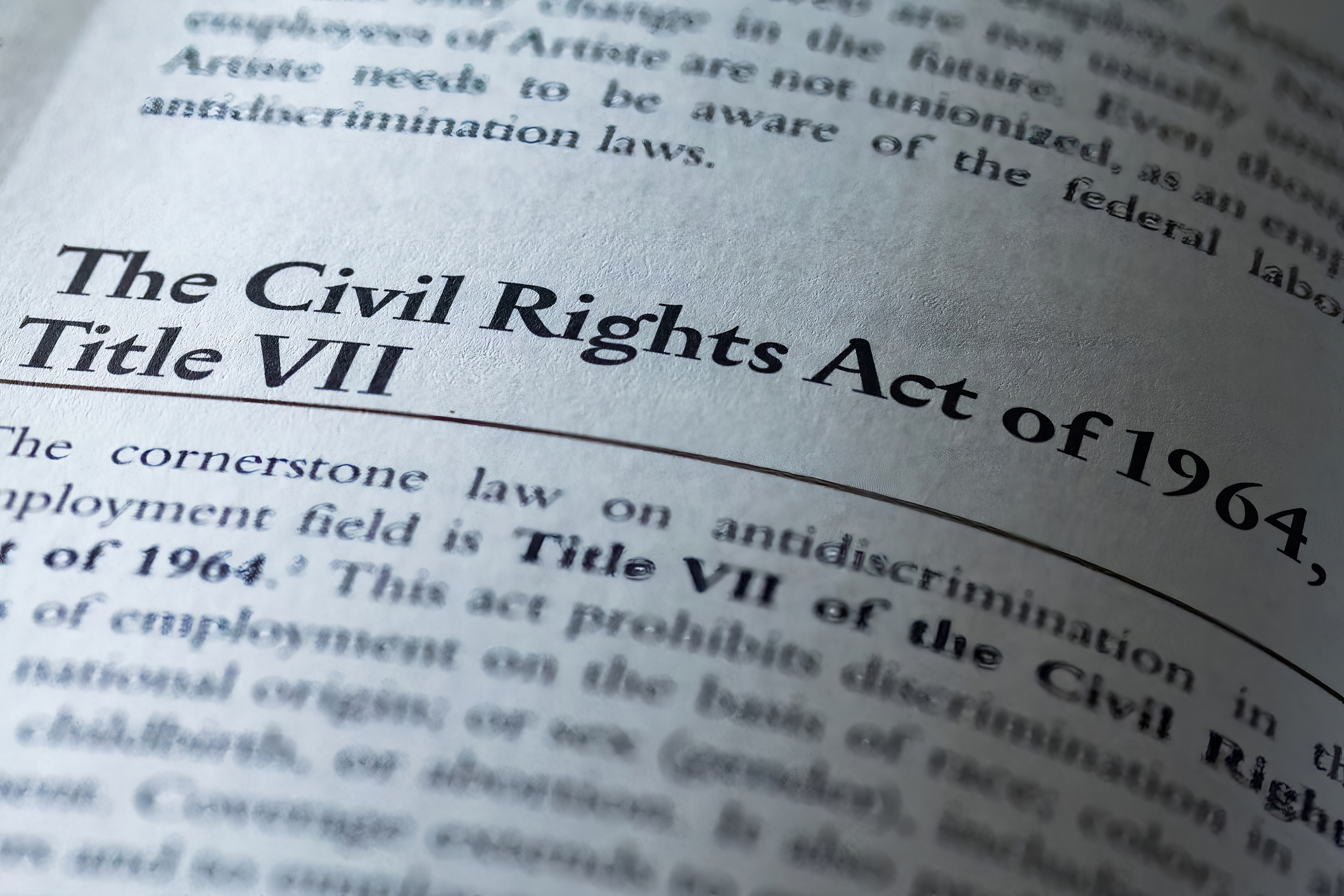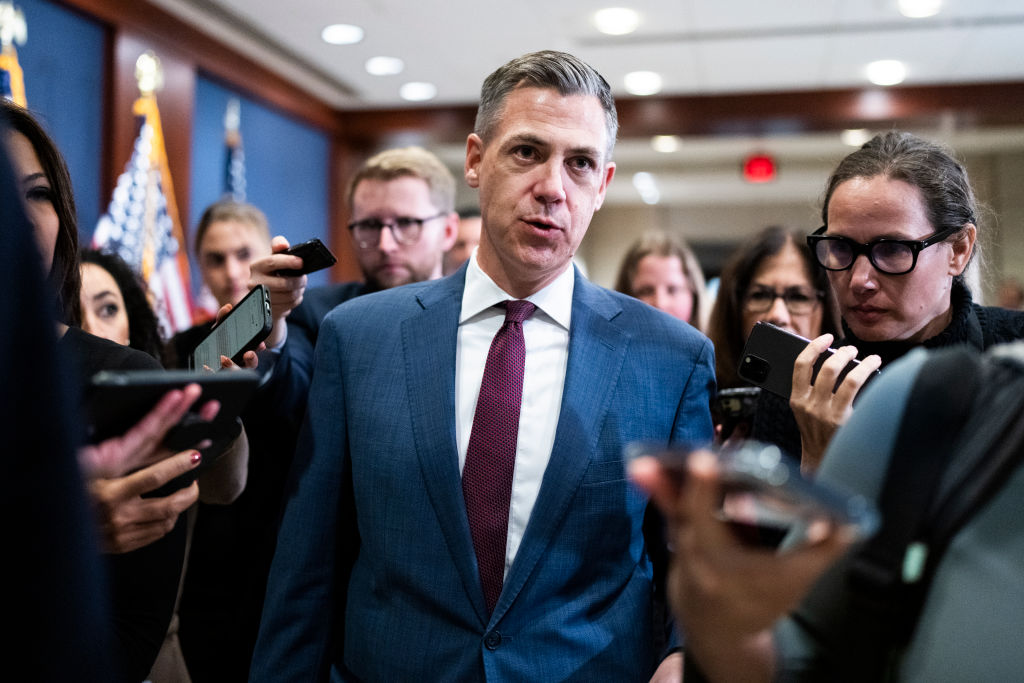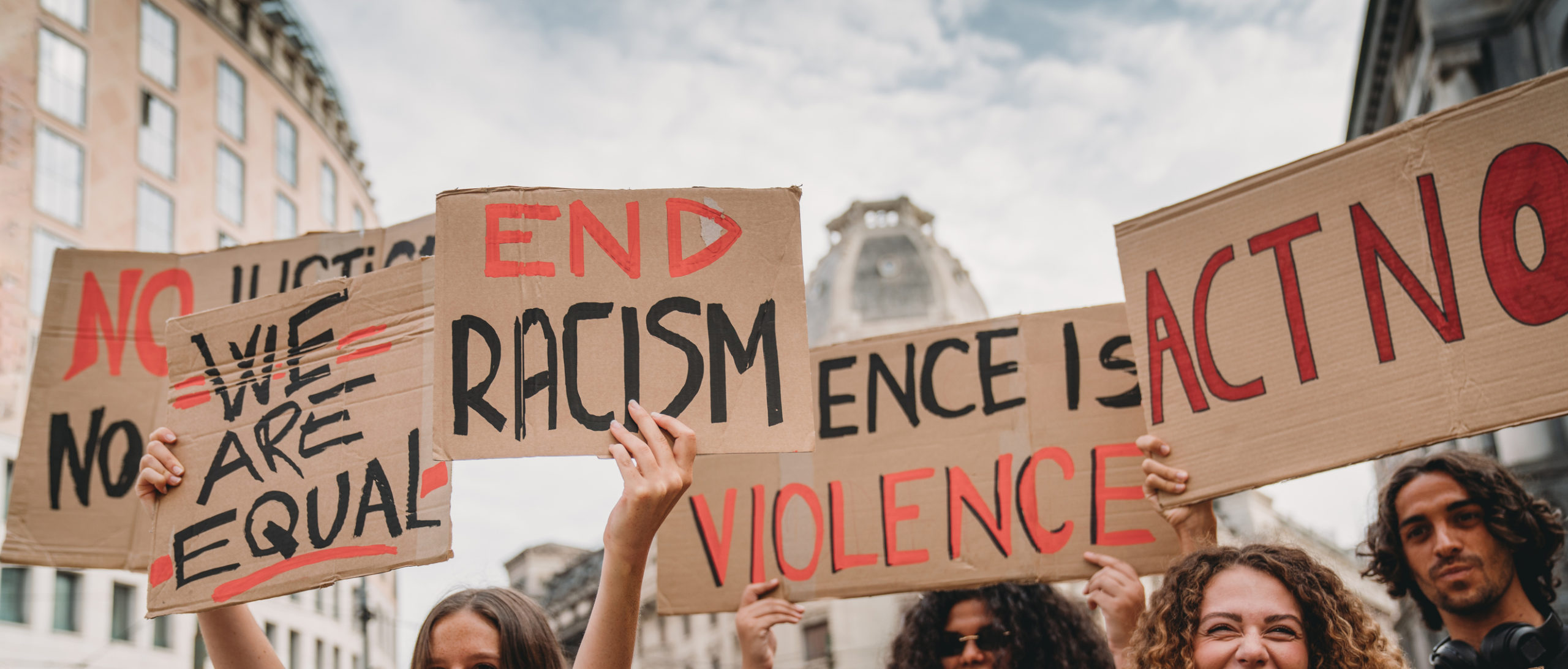There won’t be a second chance to take back hijacked American schools.
The Bigotry of Social Justice

The divisive racialist creed doesn’t add up.
Two of 2020’s best-sellers were published in 2018 and 2019, respectively: White Fragility, by Robin DiAngelo, and How to Be an Antiracist, by Ibram X. Kendi. (DiAngelo, a consultant, is white; Kendi, a professor who recently left American University for Boston University, is black.) It’s strange for books to achieve their greatest commercial success a year or more after publication, but this year’s circumstances are even stranger. In America’s reckoning over race, catalyzed by George Floyd’s death while under arrest in Minneapolis, journalists, entertainers, professional athletes, and corporations have embraced a social justice dogma. DiAngelo and Kendi’s books provide many of its core principles, which distinguish acceptable thoughts and attitudes about race from unacceptable ones.
The resulting framework’s first attribute is an unwavering focus on socioeconomic disparities that leave black Americans worse off than whites. Racial inequalities, as Reuters reports, “have proven immune to decades of laws and policies meant to address them.” As a result, blacks have “less education, less wealth, poorer health and shorter lifespans.” White adults, for example, are significantly more likely than blacks to have a four-year college degree. (Actually, blacks have made impressive progress in educational attainment. From 1995 to 2018, the proportion of black Americans over 25 years of age who had earned at least a bachelor’s degree nearly doubled, from 13.3% to 25.6%. Only because whites are getting more education, too—38.8% of white adults had bachelor’s degrees in 2018, compared to 25.4% in 1995—does this particular black-white gap persist. If closing it is of the highest urgency, then the crucial need is for white “allies” to stop sending their own kids to college.)
What and how are we to think about these disparities? Kendi and DiAngelo’s answer is that: 1) All disparities disadvantageous to blacks are entirely and solely the result of racism. 2) This means considering the possibility that choices, habits, dispositions, or abilities explain even a sliver of the disparities between blacks and whites is intolerably racist, an exercise in blaming the victim. 3) Rather than give any thought to how some blacks might improve their situation through different conduct, all whites sincerely opposed to racism must engage in an unsparing, never-ending quest to realize the enormity of their own culpability for black disadvantage.
“As an anti-racist,” writes Kendi, “when I see racial disparities, I see racism.” The only other possible explanation for these disparities, he insists, is “black inferiority.” Accordingly, “The opposite of ‘racist’ isn’t ‘not-racist.’ It is ‘anti-racist.’…. The claim of ‘not racist’ neutrality is a mask for racism.”
And, adds DiAngelo, it is a mask whites don eagerly in order to justify and maintain their advantages. Only through ruthless self-scrutiny, she says, can whites comprehend, atone for, and begin to reverse their “complicity with and investment in” racism. To be white in America, she told an interviewer, means “not being held accountable for the pain that you cause people of color,” while also “being relentlessly reinforced in superiority.” Whites who take umbrage at her analysis are exhibiting “white fragility,” which manifests power rather than vulnerability because it serves to “maintain our dominance within the racial hierarchy.”
If the personal is political, as feminists began saying 50 years ago, what is the connective tissue between whites’ contrition over their complicity with racism and the elimination of disparities between whites and blacks? Kendi’s definition—“Racism is a marriage of racist policies and racist ideas that produces and normalizes racial inequities”—doesn’t clarify matters. Law professor Randall Kennedy called it “an exercise in pure tautology.”
A more substantial addition to the evolving social justice framework is “systemic racism,” which Time magazine recently called the “phrase du jour.” (The term is, effectively, interchangeable with “structural racism.”) The adjective differentiates systemic racism from bigotry, the kind of racism that is merely interpersonal. In Stay Woke: A People’s Guide to Making All Black Lives Matter, political scientists Tehama Lopez Bunyasi and Candis Watts Smith contend that “Jim Crow, lynchings, police with dogs, the N-word, and other overt behaviors and attitudes” are manifestations of racism, but of just one type of racism. Structural racism, “covert and enduring” because it is “embedded in our everyday affairs,” refers to “the fact that political, economic, social, and even psychological benefits are disproportionately provided to some racial groups while disadvantages are doled out to other racial groups in a systematic way.”
It follows that it is necessary for whites who sincerely want to be anti-racist to renounce bigotry categorically, but also that this mere beginning is shamefully insufficient. Anti-racism really requires ceaseless work to reduce and ultimately eliminate socioeconomic disparities that are disadvantageous to blacks and other victims of discrimination. And we must do so by any means necessary, as Malcolm X often said. “The only remedy to racist discrimination is antiracist discrimination,” writes Kendi. “The only remedy to past discrimination is present discrimination. The only remedy to present discrimination is future discrimination.” Thus, in the increasingly influential social justice dogma, white privilege, white fragility, anti-racism, and systemic racism do most of the conceptual work. Unfortunately, the solidifying consensus in favor of this position owes more to intimidation than persuasion. Private companies and non-profit organizations have fired employees for expressing skepticism about BLM, for endorsing it in ways that critics found insufficiently enthusiastic, and even for citing academic studies indicating that race riots harm liberalism’s electoral fortunes. This is not the posture of a movement confident that it is propagating self-evident truths.
The resort to such bullying should alert us that the social justice dogma is deeply flawed. Four defects are particularly severe.
From Disparity to Division
First, the axiom that racism is to blame for all socioeconomic disparities where blacks come out on the short end is highly contestable.
Economist Thomas Sowell, who just turned 90, has devoted a great deal of attention over his career to analyzing inter-group differences occurring around the world and across many centuries. The trilogy he wrote in the 1990s—Race and Culture; Migrations and Culture; and Conquests and Cultures—is his most comprehensive examination of the issue. His conclusion is that wide, persistent disparities are a fact of life in every heterogenous society. If all disparate socioeconomic outcomes are bad (except, perhaps, for purely random ones) then the pursuit of justice requires constantly reducing and ultimately eliminating every such disparity. According to Sowell, however, this supposed ideal is in fact contrary to the operation of every large, complex society known to the disciplines of history and anthropology.
He offers so many particulars that it becomes clear the supply is infinite. A century ago, for example, Jews were 6% of Hungary’s population and 11% of Poland’s, but accounted for the majority of physicians in each country. Indonesia’s ethnic Chinese minority, about 5% of the population, owns some 80% of the nation’s invested capital. In the multinational Austro-Hungarian empire, 75% of Serbo-Croatian adults were illiterate in 1900, as were 40% of Poles, but only 6% of Germans.
Among the large number of immigrants who came to America in the late 19th and early 20th centuries, those from northern Europe were more likely to come from cities, where an extensive division of labor made it both necessary and possible to acquire specialized skills. Those from southern and eastern Europe usually came from rural areas lacking such opportunities. As a result, immigrants from Mediterranean and Slavic countries had incomes that were only 15% as large as those who came from Scandinavia, the Netherlands, and Great Britain. By the same token,
Japanese and Mexican immigrants began arriving in California at about the same time and initially worked in very similar occupations as agricultural laborers. Yet a study of a school district in which their children attended the same schools and sat side-by-side in the same classrooms found IQ differences as great as those between blacks and whites attending schools on opposite sides of town in the Jim Crow South.
Why do such large disparities exist? Discrimination is a factor, Sowell says, but not the only one, the biggest, or one that operates in a simple linear fashion. The groups most discriminated against, in other words, are not always or even usually the most disadvantaged, and the groups doing the discriminating are not necessarily the most advantaged.
If discrimination were the sole or decisive factor explaining group disparities, argues Sowell, we should expect the descendants of African slaves in Haiti to be far better off than the descendants of African slaves in the United States. Haiti, after all, has been an independent nation for two centuries, in which the huge black majority has been politically and economically dominant. In the U.S., blacks are a minority, slightly more than one-eighth of the population, subjected to various forms of discrimination since the Thirteenth Amendment outlawed slavery. And yet, he writes, “it is Haitians who are the poorest and American blacks who are the most prosperous in the [western] hemisphere—and in the world.”
Often more important than discrimination, Sowell contends, are cultural differences among groups. As it pertains to flourishing or falling behind in terms of economic prosperity, culture refers to “knowledge, skills, experiences and habits.” And, in turn, the ultimate cause for this proximate cause is, not always but often, geography. “The physical settings in which races, nations, and civilizations have evolved have had major impacts on the cultures developed within those settings.” All else being equal, it is better to be exposed to other peoples and their innovations than to be isolated from other peoples and, thereby, unable to copy or adapt advances they have made.
[When] the British first crossed the Atlantic and confronted the Iroquois on the eastern seaboard of what is today the United States, they were able to steer across the ocean in the first place because they used rudders invented in China, they could navigate on the open seas with the help of trigonometry invented in Egypt, their calculations were done with numbers invented in India, and their general knowledge was preserved in letters invented by the Romans. But the Iroquois could not draw upon the knowledge of the Aztecs or the Incas, whose very existence they had no way of knowing. The clash was not between the culture created by the British versus the culture created by the Iroquois. It was a clash between cultural developments drawn from vast regions of the world versus cultural developments from a much more circumscribed area. The cultural opportunities were unequal and the outcomes were unequal.
“Geography has never been egalitarian,” Sowell concludes, the foremost example of what he calls “cosmic injustice.” He distinguishes it from social injustice, a factor constantly discussed but whose importance is almost always exaggerated. Because of geographic and historical happenstance, there can be enormous disparities that have nothing to do with the abuse or exploitation of one group by another.
Thus, no account of the poverty of sub-Saharan Africa, and of people of African ancestry living elsewhere in the world, can ignore the cosmic injustice of how Africa’s geography isolated its inhabitants and limited their exposure to other peoples’ civilizational advances. Europe has rivers that are navigable year-round and hundreds of miles long; Africa’s rivers are interrupted by droughts, cascades, and waterfalls. “Although Africa is more than twice the size of Europe, it has a shorter coastline. That is because the European coastline continually twists and turns, creating innumerable harbors, while the African coastline is smooth, with few harbors.” One consequence of Africa’s peoples being isolated from one another and from the rest of the world, Sowell says, is that sub-Saharan Africa accounts for one tenth of the world’s population but one third of its languages.
The social justice jihad against socioeconomic disparities is not only infeasible but also pernicious, leading inevitably to resentment, envy, and discord. If white privilege explains virtually everything about how whites come out ahead of blacks, how can “Jewish privilege” not explain how Jews come out ahead of Gentiles? How can “Asian privilege” not explain the educational and economic advantages that Americans of Asian ancestry enjoy over whites, blacks, and Hispanics? After all, the social justice framework demands summary rejection of the idea that there are reasons other than racism why some groups, including ones that have endured virulent bigotry within living memory, get along better in the modern world than other groups.
Seen in this light, there’s a perverse logic to black anti-Semitism, despite the fact that its most prominent adherents, such as Louis Farrakhan, go out of their way to make their anti-Semitism not just as crazy and ugly as anyone else’s, but decidedly crazier and uglier. Willie Sutton robbed banks because that’s where the money is, so black anti-racists denounce Jews on the theory that that’s where the privilege is.
Nine U.S. senators are Jews, for example, and three are black, even though blacks outnumber Jews 13% to 2% in the national population. In other words, blacks have less than one-fourth the Senate seats we would expect if a national lottery rather than state elections determined membership in that club, while Jews have three-and-a-half times more than we would expect.
There are only 100 senators, so the zero-sum, anti-racist logic insisting that blacks must never be under-represented necessarily demands that no other group be over-represented. And since the most over-represented groups constitute the biggest affront to disparity-free, proportional racial justice, it follows that blacks and their allies should go after those groups first—and hardest—if we are ever going to realize true equality in this benighted land.
The same illogic applies to Asians. Last year’s controversy over New York City’s highly selective specialized high schools concerned the admissions exam, alleged (by the mayor and school superintendent, among others) to be racist because black and Hispanic students were under-represented at prestigious schools like Bronx Science and Stuyvesant (where Sowell went to high school). Specifically, they accounted for 10% of the student body at these schools despite numbering two-thirds of all the city’s public-school students.
Meanwhile, white and Asian students were over-represented…but to radically different degrees. Whites account for 15% of all NYC students and 24% of those at the specialized schools, which means that they’re three-fifths again as likely to get into the specialized schools as you would expect if placement were determined through a city-wide lottery. Asian students, however, are 16% of all NYC pupils but 62% of those in the selective schools: there are nearly four times as many Asian students in New York’s specialized high schools as simple demographic proportions would predict.
Thus, a coherent but also absurd way to blame racism for the small number of black and Hispanic students at Stuyvesant and Bronx Science would be to hold that New York’s whites have devised an admissions process that is far more beneficial to Asians than to whites because white racism is so pathological that its highest priority is to harm blacks rather than help whites.
In other words, if the concept of white privilege demands that we explain disparities that favor whites over blacks in terms of racism, it is hard to deny the power of Jewish and Asian privilege, given the disparities advantageous to Jews and Asians. Conversely, if you reject Jewish and Asian privilege as a stupid, vicious idea—the decent and sensible conclusion—it becomes much harder to find white privilege compelling, either as a sociological explanation or a moral guide.
Anti-Science
The social justice dogma’s second difficulty is that its central contentions are fundamentally flawed by virtue of being unfalsifiable. Despite sympathizing with Robin DiAngelo’s political goals, the Washington Post objected that her concept of white fragility is “irrefutable” because of its reliance on “circular logic.” “Either white people admit their inherent and unending racism and vow to work on their white fragility, in which case DiAngelo was correct in her assessment, or they resist such categorizations or question the interpretation of a particular incident, in which case they are only proving her point.” By treating dissent from her thesis as further evidence for it, DiAngelo makes coherent argument about that thesis impossible.
When challenged in the white fragility workshops she conducts, DiAngelo sometimes responds, “I am offering you a teachable moment.” But now that she has settled on the construct that has made her reputation and livelihood, there’s no evidence that DiAngelo is capable of viewing any criticism, no matter how thoughtful, as a learnable moment.
In the same way, the conceptual validity of systemic racism, its ability to explain social phenomena, rests on the prior assumption of its validity. In Sowell’s clinical language, systemic racism “really has no meaning that can be specified and tested in the way that one tests hypotheses.” The vast literature on the subject appears to include no instance where: a) someone ascribes a social ill to systemic racism and, then, b) other thinkers conversant with the concept reject this explanation, countering that systemic racism, in this instance, accounts for very little of the phenomenon under discussion.
Somewhat cagily, Bunyasi and Smith say in Stay Woke that systemic racism is “difficult to see if you do not know what you’re looking for.” Galileo could have said the same thing, of course, but so too can an astrologer. The difference between them is that an astronomer’s hypotheses can be provisionally accepted, modified, or rejected on the basis of empirical evidence, while the astrologer’s claims cannot. That systemic racism is closer to astrology than science is indicated by Bunyasi and Smith’s reliance on the passive voice to account for phenomena crucial to their argument. Benefits are provided and disadvantages are doled out because of systemic racism, they say, without identifying who or what is doing all this providing and doling.
It should be no surprise that the most important axioms of the social justice ideology fail the usual standards of empirical proof and logical rigor. Its leading exponents have made clear that they reject all such standards. DiAngelo is fond of the rhetorical question, “From whose subjectivity does the ideal of objectivity come?” Her point, explains the New York Times, is to ask “whether what we define as scientific research and scholarly rigor, and what we venerate as objectivity, can be ways of excluding alternate perspectives and preserving white dominance.”
Kendi takes the same stance. “I think Americans need to decide whether this is a multicultural nation or not,” he told the Times. “If Americans decide that it is, what that means is we’re going to have multiple cultural standards and multiple perspectives.” As of yet, however, we haven’t decided “whether we desire a multicultural nation or a unicultural nation.”
DiAngelo and Kendi are the latest of many advocates to apply the ideas of deconstruction and postmodernism to the work of social transformation. “The master’s tools will never dismantle the master’s house,” the black feminist Audre Lorde declared in 1984. “They may allow us temporarily to beat him at his own game, but they will never enable us to bring about genuine change.” Educational psychologist Alison Bailey unpacked Lorde’s metaphor in 2017. For those who “seek justice and emancipation,” she wrote, such analytical standards as “validity, soundness, [and] conceptual clarity” are not merely unnecessary but harmful. Accordingly, it is imperative to assess arguments made “in response to social-justice issues not as propositions to be assessed for their truth value, but as expressions of power that function to re-inscribe and perpetuate social inequalities.”
An obvious disadvantage of repudiating logical and empirical rigor is that doing so has proven highly conducive to spouting fatuous gibberish. One of the offsetting advantages is that you inoculate yourself from charges of being illogical and inconsistent after you renounce logical consistency. Though still in his thirties, Kendi has already received a diagnosis of metastatic stage-4 colon cancer. Thankfully, six months of chemotherapy followed by surgery left him and his doctors guardedly confident that the malignancy had been completely removed and will not recur. It’s not surprising that Kendi calls for increased public spending on the “cancer research, prevention, and treatment that can reduce the second-leading cause of death.”
It is striking, though, that the discipline of oncology presents an excellent opportunity, which Kendi never mentions, for America to become more multicultural and less unicultural. The master’s tools of scientific analysis and rigor have been crucial to developing the medicines and surgical procedures that saved Kendi’s life, as well as diagnostic measures like colonoscopies, which have saved thousands of other lives.
A nation more deeply committed to social justice, however, would be far more receptive than Kendi appears to be to a wide range of alternative regimens, and even definitions, of medicine and health. Already, the social justice warriors who denounce “fat-shaming” are re-inscribing the meaning of morbid obesity from a colorblind malady to an anti-racist identity. Medical professionals have had to urge “woke” feminists taken in by Gwyneth Paltrow’s high-end wellness brand Goop not to believe its claims about the benefits of using the pricey jade “eggs” it markets as genital inserts. We would expect the recipients of post-scientific health treatments to die at a much higher rate than those in a control group undergoing the sort of Euro-centric therapies Kendi and most others receive. But to think that such results would prove anything, or should guide medical practice going forward, is to traffic in dubious concepts like validity, soundness, and conceptual clarity, thereby perpetuating social inequalities.
Deconstructing Democracy
The third problem with the social justice consensus follows directly from the second. Since it rejects Enlightenment principles for formulating, evaluating, and debating ideas, it only makes sense that modern anti-racism also rejects Enlightenment principles about living together peacefully and fairly: inalienable rights, humans’ inherent equality and dignity, constitutionalism, tolerance, pluralism, and governments which derive their just powers from the consent of the governed. Social justice opposes and threatens liberal democracy by rejecting such principles, along with institutional pillars like a free press and independent courts, as devices that perpetuate and legitimate the oppression of the oppressed.
Last year Politico asked a number of thinkers to propose the one reform they considered most necessary and beneficial. Ibram Kendi made sure that no one would accuse him of endorsing half-measures. He called for a constitutional amendment to create a Department of Antiracism. The DOA—Kendi’s acronym, but also a succinct description of what constitutional democracy will be if his reform is enacted—“would be responsible for preclearing all local, state and federal public policies to ensure they won’t yield racial inequity, monitor those policies, investigate private racist policies when racial inequity surfaces, and monitor public officials for expressions of racist ideas.”
In other words, if the constituents who elected any of the nation’s governors, mayors, state legislators, aldermen, etc. wanted one thing, but the DOA opposed it, the department rather than the citizens would prevail. Permanently funded and staffed by “formally trained experts on racism,” but with “no political appointees,” the department would be answerable only to itself, neither checked by other branches of government nor constrained by voter disapproval. Indeed, it would be “empowered with disciplinary tools to wield over and against public officials and policymakers who do not voluntarily change their racist policy and ideas.”
According to philosophy professor Stephen R.C. Hicks, postmodernism takes up where the ancient Greek sophists left off. The sophists argued that there was no objective basis for preferring one moral or political order to another. Politics consisted entirely of competing interests, and the acquisition and exercise of the power to advance them. In Plato’s Republic, the sophist Thrasymachus insists that justice is nothing other or more than the interest of the stronger. That is, justice has no meaning or moral force, but is simply a word that sounds noble. The powerful use it to rationalize and perpetuate their power, to convince those against whom they exercise power to accept their subjugation as not merely a practical accommodation but a moral duty.
Social justice theorists, Hicks says, agree about the meaninglessness of justice, but reverse Sophism by taking the position that justice is the interest of the weaker. It is clear, again, that postmodernism’s rejection of those master’s tools which include logical consistency and coherence is highly useful to the social justice project. There is no particular reason why the interests of the weaker are morally preferable to anyone else’s, either in general or in any particular instance.
Nor is there any obligation to justify this political position. There is only a turtles-all-the-way-down rationale: all the moral arbiters that social justice advocates consider worth listening to—i.e., one another—have the same view about the paramount importance of uplifting the downtrodden, which validates it as much as any idea can be validated.
Pursuing social justice while also scorning justice entails several difficulties. Two among them, one practical and one theoretical, are especially significant. The practical one is that advancing the interests of the weaker by any means necessary requires judgments that social justice dogma cannot always make. In 2015, after two Muslim gunmen murdered 11 people at the Paris offices of the satirical magazine Charlie Hebdo, American cartoonist Garry Trudeau, creator of “Doonesbury,” ascribed more blame to the victims than to their assailants. “Satire punches up, against authority of all kinds, the little guy against the powerful,” he said. “By punching downward, by attacking a powerless, disenfranchised minority with crude, vulgar drawings closer to graffiti than cartoons, Charlie wandered into the realm of hate speech …”
Ross Douthat objected: “The terrorist’s veto on portrayals of Islam is itself a very real form of power, and as long as journalists who challenge it end up dead, the idea that they are ‘up’ and their targets are ‘down’ reflects a denial of life-and-death reality.” So did David Frum. Trudeau’s simple two-part moral test—identify the more privileged party in any conflict, then hold that party responsible for the conflict—ignores the fact, Frum said, that there are “many dogs in any fight, and the task of identifying which one is the underdog is not so easy.”
Douthat offered another example supporting the point: “the hundreds of white women recently raped by Pakistani gangs in England’s industrial north were theoretically higher on a ladder of privilege than their assailants. But the gangs’ actual power over their victims was only enhanced by that notional ladder, because multicultural pieties were part of what induced the authorities to look the other way.”
The theoretical difficulty with the social justice framework is that, for all the operatic denunciations of white privilege and perfidy, there’s ultimately no need for anyone to apologize for anything in a world filled with clashing interests but devoid of moral standards. If politics is simply about who gets what, and it is understood that all humans will attempt to get as much as they can, then history’s subjugators did not really commit any transgressions. They just won. And those who have inherited the privileges those winners secured have no more right to perpetuate their advantages than do those who want to take them away. But they also have no less. This nihilistic worldview reverses Clausewitz’s famous dictum: politics is now simply war carried out by other means.
The New Savagery
Social justice advocates are sure to dismiss these first three objections as nothing more than efforts to justify white power and privilege, fortifying the master’s house by using the master’s insidious tools, evidence and logic. It may be more difficult to brush aside a fourth and final argument, which is that the social justice dogma of our day is beset by manifest condescension and even contempt for blacks, supposedly the objects of its solicitude.
To ascribe all moral and practical responsibility for disparities adversely affecting blacks to white racism requires insisting that higher rates of criminal behavior and out-of-wedlock births among blacks, to mention the two likeliest causes of chronic poverty, are either inconsequential or themselves the result of white racism. To take that position, however, is to contend that the minimal decencies and competencies we demand of everyone else are somehow an unwarranted expectation for this one victimized group. In the words of economist Glenn Loury (who, like Sowell, is black):
You’re telling me that people have to run up and down the street, firing guns out of windows and killing their brethren because we didn’t get reparations for slavery handed over to you yet?… And you’re telling me that that explains or somehow excuses or cancels out the moral judgment that I would otherwise bring to bear against any other community in which I saw this happening?
Loury is not alone in noticing this problem. When White Fragility was published, a white woman on the New Yorker staff wrote a rapturous review. “DiAngelo, for all the outrageousness she documents, never comes across as anything other than preternaturally calm, patient, and lucid, issuing prescriptions for a better world,” Katy Waldman declared. A year later, the magazine took the highly unusual step of publishing a second review, one by Kelefa Sanneh that also examined How to Be an Antiracist.
Sanneh’s mother is a white South African and his father, who died last year, was a black man from Gambia. In his reading, White Fragility reduces all of humanity to whites and “people of color,” who “function in this world as sages, speaking truths that white people must cherish, and not challenge.” For all DiAngelo’s scolding, this treatment “makes white people seem like flawed, complicated characters; by comparison, people of color seem good, wise, and perhaps rather simple.”
Writing for The Atlantic, John McWhorter, a black professor of linguistics, was considerably more caustic. White Fragility, he concludes, is “a book about how to make certain educated white readers feel better about themselves,” but which does so by teaching them “how to be racist in a whole new way.” McWhorter says that he cannot imagine that there are blacks who “could willingly submit themselves to DiAngelo’s ideas while considering themselves adults of ordinary self-regard and strength. Few books about race have more openly infantilized Black people than this supposedly authoritative tome.”
This contempt for blacks—the all-but-explicit belief that respecting blacks requires, as it does for children or the mentally disabled, making excuses and accepting otherwise unacceptable conduct—is not one of social justice’s fixable problems, but one of its integral features.
This became clear recently when the National Museum of African American History & Culture posted on its website a page on “Aspects and Assumptions of Whiteness & White Culture in The United States.” Starting from the premise that “white people and their traditions, attitudes and ways of life have been normalized over time and are now considered standard practices in the United States,” the website went on to list some of these debilitating, insidious manifestations of whiteness: self-reliance; independence and autonomy being highly valued and rewarded; the nuclear, two-parent family; “objective, rational linear thinking”; “cause and effect relationships”; “quantitative emphasis”; the belief that “hard work is the key to success”; “work before play”; “respect authority”; “plan for future”; “delayed gratification”; and “must always ‘do something’ about a situation.”
Many critics objected, some making the argument that a white supremacist organization would certainly be denounced if its website asserted all the corresponding propositions with similar bland confidence—that the defining characteristics of blackness in America included: dependency; informal, ad hoc connections between procreation and child-rearing; irrationality; innumeracy; laziness; irresponsibility; being disrespectful; being disorganized; lack of impulse control; and passivity. After several days of bad publicity, the museum deleted the graphic from its website. “We have listened to public sentiment and we have removed a chart that does not contribute to the productive discussion we had intended,” the museum’s statement said.
The website controversy was an example of an institution committing a gaffe, which is usually the blunder of an individual politician. Michael Kinsley defined it as blurting out the controversial opinion you actually hold rather than taking shelter in the euphemisms designed to obscure it. The website material came from White Awareness: Handbook for Anti-Racism Training (1978), by Judith Katz, a pioneer in the growing and increasingly lucrative field of diversity consulting. According to the New York Times, Katz’s views embody the industry consensus.
A 2017 academic article coauthored by Robin DiAngelo claims that the modern university, “with its ‘experts’ and its privileging of particular forms of knowledge over others (e.g., written over oral, history over memory, rationalism over wisdom),” has “validated and elevated positivistic, White Eurocentric knowledge over non-White, Indigenous and non-European knowledges.” Another diversity consultant, Glenn E. Singleton, told the paper, “There’s this whole group of people who are named the scientists. That’s where you get into this whole idea that if it’s not codified in scientific thought that it can’t be valid.”
The idea that modern society is, in the words of the Times, “rigged at its intellectual core,” is meant to indulge blacks and undermine white “hegemony,” but has the effect of abusing people of all colors. The social justice project’s whole point is to make white people feel responsible for blacks’ disadvantages, and thereby committed to eliminating them. There is no logical contradiction between this mission and reaching the conclusion that blacks’ disadvantages are explained, to some significant degree, by factors other than white racism.
The reformer who accepts that racism is bad but only one cause among many for black poverty will try to define the public policies and social structures that do the most to help poor people prosper. This work will require the exact tools social justice doctrine scorns: rationality, causality, quantitative measurement, hard work, and the determination to do something about a situation.
There is, however, a serious political tension between inducing white guilt and acknowledging sociological complexity. To entertain the idea that disparities can have causes other than racism or black inferiority poses a danger: some whites will conclude that they don’t need to feel as guilty and resolute as the social justice movement wants them to.
Rather than risk this outcome, the social justice movement takes the reductive, insulting position that what blacks are is solely and simply a function of how whites have treated them, which means that any and all prospects for blacks becoming wealthier, better educated, healthier, etc. depend entirely on how whites adjust their own thinking and conduct.
This is social justice’s “noble lie.” Its dishonesty is undeniable, but its nobility is highly doubtful. “The fact that discrimination deserves moral condemnation does not automatically make it causally crucial,” Sowell concludes. “A confusion of morality with causation may be politically convenient but that does not make the two things one.”
It makes sense to blame human beings for biased rules and standards. But who is to be blamed for circumstances that are the results of a confluence of all sorts of conditions of the past and present, interacting in ways that are hard to specify and virtually impossible to disentangle? Unless we wish to start a class action suit against geography or against the cosmos or the Almighty, we need to stop the pretense that somebody is guilty whenever the world does not present a tableau that suits our desires or fits our theories.
The American Mind presents a range of perspectives. Views are writers’ own and do not necessarily represent those of The Claremont Institute.
The American Mind is a publication of the Claremont Institute, a non-profit 501(c)(3) organization, dedicated to restoring the principles of the American Founding to their rightful, preeminent authority in our national life. Interested in supporting our work? Gifts to the Claremont Institute are tax-deductible.
The Civil Rights Division of the Department of Justice should be disbanded.
The latest National Defense Authorization Act is a step in the right direction.
The warning is coming from inside the bubble.
Critical race theory was never designed to reveal truth—it was designed to achieve power.
Progressives argue that failing to define their terms their way is racist.






